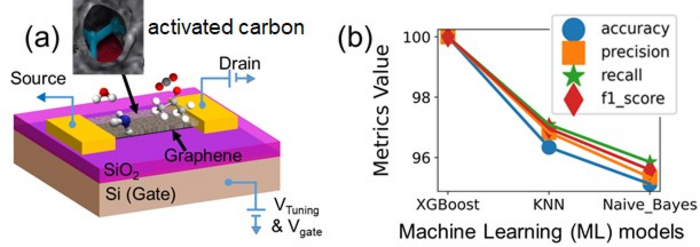Where gas sensors are concerned, the 2D nature of graphene makes it suitable for such applications. However, as a result of its intrinsic non-selectivity and huge p-doping in atmospheric air, its applications in gas sensing are often restricted to controlled environments like dry air, nitrogen, or synthetic humid air.

(a) The schematic diagram of the activated-carbon functionalized graphene sensor. (b) The comparative plot of the XGBoost, KNN, and Naïve Bayes models performance. Image Credit: Hiroshi Mizuta from Japan Advanced Institute of Science and Technology.
While humidity conditions present in synthetic air could be utilized to obtain controlled hole doping of the graphene channel, this does not properly mirror the situation in atmospheric air. Furthermore, atmospheric air consists of numerous gases with concentrations similar to or larger than the analytic gas.
Such drawbacks of graphene-based sensors impede molecular species identification and selective gas detection in atmospheric air, which is needed for non-invasive medical diagnosis of ailments and applications in environmental monitoring.
The research group headed by Dr. Manoharan Muruganathan (formerly Senior Lecturer) and Professor Hiroshi Mizuta at the Japan Advanced Institute of Science and Technology (JAIST) applied the machine learning (ML) models trained on several gas adsorption-induced doping and scattering signals to identify both selective gas and highly sensitive sensing with a single device.
The performances of the ML models are often dependent on the input features.
The conventional graphene-based ML models are limited in their input features.
Dr. Osazuwa Gabriel Agbonlahor, Japan Advanced Institute of Science and Technology
The current ML models only track the changes in graphene transfer characteristics or resistance/conductivity caused by gas adsorption without modulating these characteristics with an external electric field. Therefore, they miss the distinctive van der Waals (vdW) interaction happening between graphene and gas molecules, which seems to be specific to individual gas molecules.
Therefore, unlike the traditional electronic nose (e-nose) models, it is possible to map the external electric field modulated graphene-gas interaction, thereby allowing highly selective feature extraction for complicated gas environments like atmospheric air.
The ML models available for the identification of atmospheric gases were developed with the help of the graphene sensor that has been functionalized with a porous activated carbon thin film.
Eight vdW complex features were utilized to track the impacts of the external electric field on the graphene-gas molecule vdW interaction, and simultaneously mapped the rise of the vdW bonding before, during, and after the external electric field application.
Moreover, even though the gas sensing experiments were executed under different experimental conditions, for example gas concentrations, gas chamber pressures, atmospheric relative humidity, tuning time, ambient temperature, and tuning voltage, the developed models were displayed to be sufficiently strong to house such changes caused in experimental conditions by not exposing the models to such parameters.
Furthermore, to test the versatility of the model, they were trained on atmospheric environments as well as comparatively inert environments that are frequently utilized in gas sensing, for example, dry air, and nitrogen.
Therefore, a high-performance atmospheric gas “electronic nose” was achieved, differentiating between the four different environments (ammonia in atmospheric air, acetone in nitrogen, ammonia in dry air, and acetone in atmospheric air) with 100% precision.
Journal Reference
Agbonlahor, O. G., et al. (2023) Machine learning identification of atmospheric gases by mapping the graphene-molecule van der waals complex bonding evolution. Sensors and Actuators B: Chemical. doi.org/10.1016/j.snb.2023.133383.
Source: http://www.jaist.ac.jp/english/